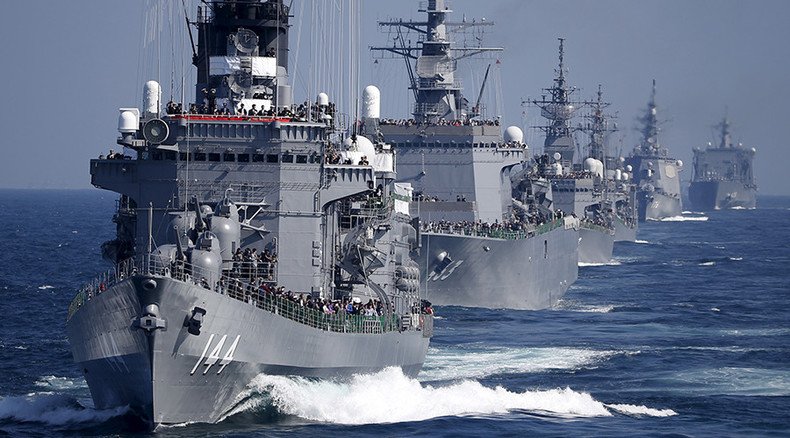Japan displays naval power as US extends home fleet’s operation to entire Pacific (VIDEO)

Japan has showcased its naval strength, including Tokyo’s latest helicopter carrier Izumo. The commander of the US Third Fleet, which was recently given a greater role in the western Pacific, visited the event.
The Fleet Review of the Japanese Maritime Self Defense Force (JMSDF) is held every three years. The display held on Sunday in Sagami Bay, southwest of Yokosuka, Kanagawa Prefecture, featured an armada of carriers, cruisers, destroyers and submarines.
The highlight of the show was Japan’s new 250 meter long helicopter carrier, the Izumo, the biggest warship Japan has built since World War II. Japan designates it a ‘helicopter destroyer’ rather than carrier to comply with the country’s pacifist constitution that renounces war and the threat of force as means to settle international disputes. Technically the country has no military and for numerous years, has not been building aircraft carriers, which are needed to wage war far from home soil.
READ MORE: Japan launches new helicopter carrier named after WWII ship
The provision, however, was reinterpreted last year as Prime Minister Shinzo Abe pushed for allowing Japan “collective self-defense” – a use of force on behalf and in defense of its allies. The allies including India, South Korea, Australia, France, and the United States, brought along their naval assets to the Japanese display.
The USS Ronald Reagan, a Nimitz-class aircraft carrier, which replaced the USS George Washington as the flagship of the only US forward-based carrier strike group, represented the American side. It arrived at its new home port of Yokosuka on October 1 to become part of the Japan-based Seventh Fleet of the US Navy.
Ships, P-1 at work during Japan's int'l. fleet review Sunday. @US7thFleet Mustin, Chancellorsville participate. pic.twitter.com/dQILw3chgW
— Erik Slavin (@eslavin_stripes) October 18, 2015PM Abe’s visit aboard the Ronald Reagan was the first time a serving Japanese prime minister had toured a US flattop. The move sparked criticism at home from politicians, who oppose Abe’s turn towards a more belligerent Japan.
Accompanying Abe was US Vice Admiral Nora Tyson who was appointed commander of the powerful Eastern Pacific Third Fleet this year. Her visit comes after the Third Fleet was given a greater role in the western Pacific.
#WorkingforDK Attended Fleet Review 2015. pic.twitter.com/S6PF1QHxHw
— Freddy Svane (@svane_freddy) October 18, 2015The US has scrapped an administrative boundary running along the International Date Line that separates the operating areas of the Seventh and Third Fleets. Previously when the home-based Third Fleet sent its warships to the western Pacific, the Seventh took command of them, but now the two fleets will be working closer together on such missions.
"Admiral Tyson's presence here is just a recognition that we are trying to be as flexible as possible to keep as many options on the table as possible so that we can be as responsive as possible," US Chief of the Naval Operations, John Richardson, said in a media briefing in Tokyo on Thursday.
#POTD WO Tim Badger pipes the 'tartan terror' #HMASStuart into Yokosuka, Japan for the Japanese #fleetreviewpic.twitter.com/rSAEhJnXfp
— RoyalAustralianNavy (@Australian_Navy) October 15, 2015The Seventh Fleet has one aircraft carrier strike group along with 80 other vessels, 140 aircraft and 40,000 sailors. The Third Fleet based in San Diego, California has more than 100 vessels, including four aircraft carriers. It was on the Third Fleet’s then-flagship, the USS Missouri, where Imperial Japanese officials officially surrendered to the US over 70 years ago.
LISTEN MORE:
The US and Japan’s naval beef-up comes as they oppose China’s reclamation of artificial islands in the South China Sea. Beijing claims sovereignty over them and the waters around it. This stance is rejected by Washington, which even plans to sail a warship within a 12-mile distance from one of the islands. It insist that it would remain in international waters.
FLEET REVIEW 2015 pic.twitter.com/kp3xXvKybn
— 燕@ブルネイ泊地 (@tubame171) October 16, 2015












